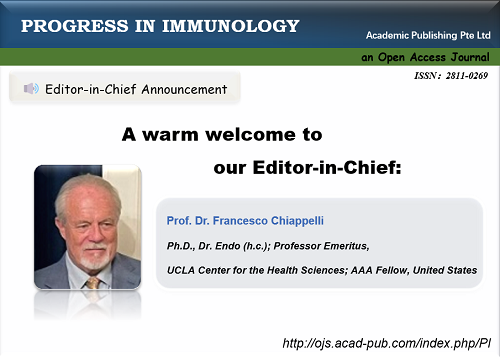
|
ISSN: 2811-0269 (Online) Journal Abbreviation: Progr. Immunol. Publication Frequency: The publication frequency of Progress in Immunology is bi-annual. Article Processing Charges (APC):Click here for more details Publishing Model: Open Access Submission to final decision: 60 days Acceptance to publication: 21 days |
About the Journal
Progress in Immunology (PI) provides a medium for disseminating significant advances in immunology, both clinical and basic immunology. The peer-reviewed open-access journal welcomes submissions from worldwide immunologist investigators, researchers, and medical practitioners, which can be original research articles, review articles, editorials, case reports, commentaries, etc. |
Announcements
Call for papers---Feature Papers |
|
Special Issue Edited by Editor-in-Chief Prof. Dr. Francesco Chiappelli Ph.D., Dr. Endo (h.c.); Professor Emeritus, UCLA Center for the Health Sciences; AAA Fellow, United States Interests:Psychoneuroimmunology; Anatomy; Ontogeny; Osteo-immunology. |
|
| Posted: 2022-01-18 | More... |
| More Announcements... |
Vol 3, No 1 (2023) (In Publishing) |
Table of Contents
|
Original Research Articles
by Xinxin Duan, Jin Dong, Shang He, Chengbin Wang, Haiwei Zhou
Progr. Immunol.
2023,
3(1), 58;
doi:
76 Views,
27 PDF Downloads
Objective: We aimed to establish and evaluate a rat model of inhalation lung injury induced by ship smoke. Methods: We monitored the changes of oxygen, carbon monoxide, carbon dioxide and hydrogen sulfide concentration within 20 min after combustion of ship materials with a AIKE four in one gas detector. We detected the changes of arterial blood gas, coagulation time, and lung moisture content (%). Macroscopic and microscopic changes in lung tissue were observed to understand the degree of lung injury. Results: We set 5 g ship materials and smoked 15 min as experimental conditions. Metabolic acidosis in the early stage after inhalation, but metabolic acidosis combined with respiratory acidosis in later stage. Histopathological observation showed diffuse hemorrhage, edema and inflammatory cell infiltration in lung tissue as manifestations of lung injury, and the injury did not recover at 72 h after inhalation, the change of blood coagulation function was not statistically significant. Conclusion: A rat model of inhalation lung injury induced by ship smoke was successfully established, which has the advantages of easy replication, stability and reliability. It can be used to research and treatment inhalation lung injury induced by ship smoke in naval war environment and other cases. |
|
Review Articles
by Alice He, Eamon Yu, Lisa Liu, Woody Wu, Rohan Rodricks, Constance Law
Progr. Immunol.
2023,
3(1), 123;
doi:
90 Views,
33 PDF Downloads
Vaccine hesitancy amongst dental health care workers (DHCW) remains a concern due to the high risk of exposure to COVID-19 and the prolonged duration of aerosol-generating dental treatments. Ubiquitous acceptance of COVID-19 vaccines is critical for achieving herd immunity to combat this pandemic. This study aims to explore the individual, interpersonal and organizational factors contributing to vaccine hesitancy in dental professionals which may assist in the development of educational programs directed at enhancing vaccine acceptance. A total of 112 papers were identified of which 23 were deemed to be suitable. The socioeconomic model was employed as a framework to evaluate the contributing factors for vaccine hesitancy. Concerns over vaccine safety, lack of information, social media, socio-economic status and trust in governmental and pharmaceutical organizations were perpetuating reasons for vaccine hesitancy. The findings of this review highlight the importance of evidence-based vaccine education programs targeted at enhancing the knowledge surrounding COVID-19 vaccines which would assist in eradicating vaccine hesitancy within the dental community. This in turn has crucial implications in promoting vaccine acceptance within the general population. |

